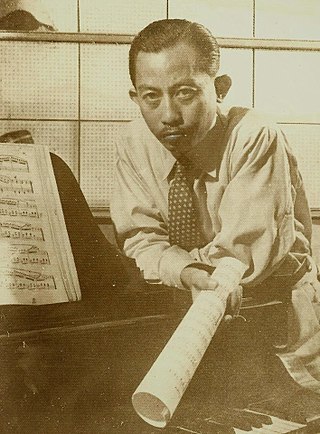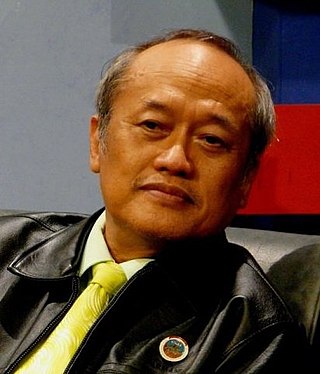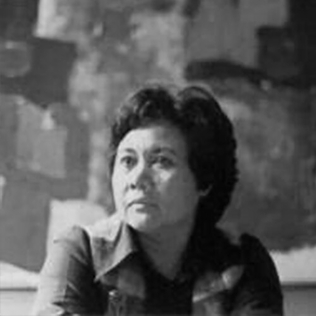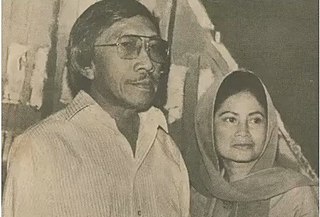
Indonesian Institute of the Arts, Surakarta is an arts university in Surakarta, Central Java, Indonesia. They are famous for teaching karawitan, wayang, Javanese dance, and other traditional crafts. The rector is Dr. Drs Guntur, M.Hum.

Mochtar Apin (23.Des.1923–01.Jan.1994) was an accomplished Indonesian painter and tenured lecturer.

Ismail Marzuki was an Indonesian composer, songwriter and musician who wrote around 202 to 240 songs between 1931 and 1958, including numerous popular patriotic songs. Among his best-known works are "Halo, Halo Bandung", "Gugur Bunga", and "Rayuan Pulau Kelapa". In 1968, he was honoured with the creation of the well-known Taman Ismail Marzuki which is a cultural centre in Menteng in central Jakarta. In 2004 he was declared one of the National Heroes of Indonesia.
Ivan Sagita was born in Malang 1957 and studied at the Indonesian Art Institute in Yogyakarta from 1979 to 1985. He is known as an introvert and mysterious artist, but his work of art is well known in the world of art.

Afrizal Malna, is an Indonesian activist, writer of prose, poetry, and theatrical texts.

Ismail Marzuki Park,, is an arts, cultural, and science center located at Cikini in Jakarta, Indonesia. Taman Ismail Marzuki complex comprises a number of facilities including six performing arts theaters, cinemas, exhibition hall, gallery, libraries and an archive building. The complex is built on an 9 hectares land area, which was previously a zoo. TIM is named after Ismail Marzuki, one of Indonesia's most influential composers.
Jim Supangkat is an Indonesian sculptor, art critic and curator.

SITI: An Iconic Exhibition of Dato' Siti Nurhaliza was a month-long fundraising exhibition of paintings and artworks that were inspired by the achievements made by Malaysian recording artist, Siti Nurhaliza. With 17 artworks from 15 Malaysian, one Spanish and one Iranian artists, the show was one of the events that is a part of Siti Nurhaliza's effort to raise funds for her foundation, Yayasan Nurjiwa. The artworks showcased range from paintings, sculptures, calligraphies, new media arts, stencil arts and mixed media arts. The exhibition is among the first of its kind in Malaysia where the main subject of the exhibition is a pop star.

Basoeki Resobowo was an Indonesian painter. Born to a transmigrant father in Sumatra, from a young age he showed interest in the visual arts but was taught to be a teacher. After a short time at a Taman Siswa school in Batavia, he studied design and worked as a surveyor while producing sketches and book covers. He only acted in a single film, Kedok Ketawa, but remained close to the acting community, first as a set designer during the Japanese occupation of the Dutch East Indies then for Perfini in the early 1950s.

Siti Zainon Ismail is a Malaysian novelist, short story writer, poet, and academic. She is best known for her multi-genre novel, Pulau Renik Ungu.

Hardi (born May 26, 1951, Blitar, is an Indonesian artist, a member of the New Art Movement.
Yoes Rizal rise in Jakarta is an Indonesian contemporary artist painter. He graduated in 1985 from Art & Design at the Institut Teknologi Bandung (ITB), under Indonesian Prof. Muchtar Apin, prof. Kaboel Soeadi, Prof. Ahmad Sadali, Dr Sanento Yuliman, Umi Dachlan and Joan Sommers, American artist and master of Sumi-e.
Freddy Sofian was an Indonesian artist.

Indonesian painting has a very long tradition and history in Indonesian art, though because of the climatic conditions very few early examples survive, Indonesia is home to some of the oldest paintings in the world. The earliest Indonesian paintings were the rock paintings of prehistoric times, such as the petroglyphs found in places like in the caves in the district of Maros in Sulawesi, Indonesia. The Stone Age rock paintings found in Maros Cave are approximately 40,000 years old and are listed as one of the oldest paintings in the world.
Siti Adiyati Subangun, better known as Siti Adiyati, is an Indonesian contemporary artist, educator, writer, and activist. Her work explores issues of social inequality, environmental degradation, and bureaucratic corruption.

Umi Dachlan, born Umajah Dachlan,, was a pioneering Indonesian painter and an art lecturer. She graduated from the Faculty of Fine Arts and Design at the Bandung Institute of Technology ITB in 1968 as the third female graduate, where she also become the first female lecturer. Her work has been described as Abstract expressionism with a figurative Lyricism.

Prof. Emeritus Drs. Abdul Djalil Pirous, known as A.D. Pirous, is an Indonesian fine arts artist and lecturer. He is a pioneer in graphic design education at the Fine Arts Institute of Technology in Bandung, and the founder of an art and design studio called Decenta (1973–1983). A.D. Pirous is married to Erna Garnasih Pirous, and the couple has three children.

Ahmad Sadali comes from a family with diversified batik and printing businesses. He was an Indonesian painter and art lecturer who is well-known for his abstract art, especially Abstract expressionism, and Cubism and Color field painting. Sadali was among the first and leading students of Ries Mulder, that represented "The Bandung School" of Indonesian art. He is considered one of the most important Indonesian modernist artists, and his works are among the highest priced Indonesian in International art markets. His signature Abstract style expresses elements of nature and spirituality in a bold yet nuanced manner.

Dolorosa Sinaga is an Indonesian sculptor, feminist and human rights activist. She was previously dean of the faculty of fine arts at the Institut Kesenian Jakarta and founder of the Somalaing Art Studio which she has operated in Jakarta since 1987. Her works appear in the National Gallery of Indonesia and internationally.
Amrizal Salayan is an Indonesian artist and sculptor.













